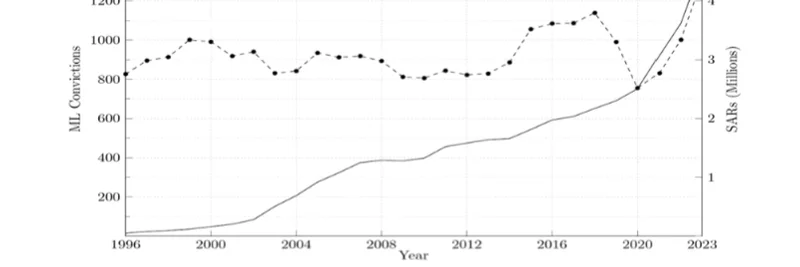Haseeb Qureshi, the managing partner at Dragonfly Capital, just dropped a bombshell on X that's got the crypto world buzzing. In his recent tweet, he highlights a "crazy chart" showing how the explosion in Bank Secrecy Act (BSA)-mandated reporting hasn't budged the needle on money laundering convictions over the past 25 years. If you're in the blockchain space—whether trading meme tokens or building DeFi projects—this is a wake-up call about the flawed system we're all navigating.
The Chart That Says It All
Look at that graph: Suspicious Activity Reports (SARs) filed with the Financial Crimes Enforcement Network (FinCEN) have skyrocketed from under 200,000 in the late '90s to over 4 million by 2023. Meanwhile, the number of offenders sentenced in federal courts for money laundering? It's hovered around 1,000 to 1,500 convictions per year, barely changing despite all the extra surveillance and paperwork.
Haseeb calls it the "AML/KYC panopticon"—a fancy way of saying it's like a massive watchtower spying on everyone's financial moves, inspired by philosopher Jeremy Bentham's prison design. Anti-Money Laundering (AML) and Know Your Customer (KYC) rules are supposed to catch crooks washing dirty money through banks and exchanges. But as the data shows, they're not deterring or catching more launderers; they're just creating a mountain of reports that lead nowhere.
Why This Matters for Crypto and Meme Tokens
In the crypto ecosystem, AML/KYC compliance is a daily reality. Exchanges like Binance and Coinbase require users to verify identities to prevent illicit activities, but Haseeb's point hits home: is all this effort actually working? For meme token enthusiasts, this could mean rethinking how regulations impact decentralized finance (DeFi) and token launches. Meme coins often thrive on anonymity and quick trades, but heavy-handed rules might stifle innovation without delivering real security.
Think about it—trillions of dollars flow through crypto markets, including viral memes like Dogecoin or newer ones on Solana. If the traditional system's broken, as evidenced by sources like the U.S. Sentencing Commission and FinCEN data, maybe blockchain's transparent ledgers offer a better path. Projects using on-chain analytics could potentially spot suspicious patterns more efficiently than outdated reporting mandates.
Community Reactions and Broader Implications
The tweet sparked quick responses. One user likened AML to "mass surveillance theater," arguing it's more about bloating budgets than stopping crime. Another questioned what could fix the system, while skeptics debated the chart's interpretation. It's clear this debate isn't going away, especially as regulators push for stricter crypto oversight.
For blockchain practitioners, this underscores the need for smarter compliance tools. Tools like Chainalysis or Elliptic help track illicit flows on blockchains, potentially outperforming the BSA's blanket approach. As meme token creators and traders, staying informed on these issues can help navigate potential crackdowns and advocate for balanced policies.
Haseeb's frustration is palpable: "Infuriating that people defend this system." If you're building or investing in meme tokens, consider how ineffective regs might create opportunities—or hurdles—in the evolving landscape. Keep an eye on Dragonfly Capital for more insights; they're at the forefront of funding innovative crypto projects.
What do you think—time to overhaul AML/KYC, or is there more to the story? Drop your thoughts in the comments below.


